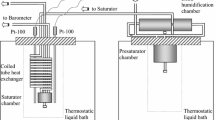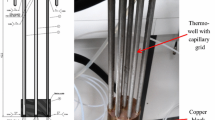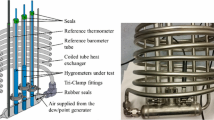Abstract
The aim of this paper is to describe the evaluation process of the performance of the low-range saturator (LRS), when exposed to two different thermal environments. The examined saturator was designed, built, and tested at MIKES (Centre for Metrology and Accreditation, Finland), and then transported to the Laboratory for Process Measurement (LPM) in Croatia, where it was implemented in a new dew-point calibration system. The saturator works on a single-pressure–single-pass generation principle in the dew/frost-point temperature range between \(-70\,^{\circ }\hbox {C}\) and \(+5\,^{\circ }\hbox {C}\). The purpose of the various tests performed at MIKES was to examine the efficiency and non-ideality of the saturator. As a test bath facility in Croatia differs from the one used in Finland, the same tests were repeated at LPM, and the effects of different thermal conditions on saturator performance were examined. Thermometers, pressure gauges, an air preparation system, and water for filling the saturator at LPM were also different than those used at MIKES. Results obtained by both laboratories indicate that the efficiency of the examined saturator was not affected either by the thermal conditions under which it was tested or by equipment used for the tests. Both laboratories concluded that LRS is efficient enough for a primary realization of the dew/frost-point temperature scale in the range from \(-70\,^{\circ }\hbox {C}\) to \(+5\,^{\circ }\hbox {C}\), with flow rates between \(1\hbox { L}{\cdot }\hbox {min}^{-1}\) and \(2.5\hbox { L}{\cdot }\hbox {min}^{-1}\). It is also shown that a considerable difference of the pre-saturator efficiency, indicated by two laboratories, did not have influence to the overall performance of the saturator. The results of the research are presented in graphical and tabular forms. This paper also gives a brief description of the design and operation principle of the investigated low-range saturator.






Similar content being viewed by others
References
D. Zvizdic, M. Heinonen, D. Sestan, Int. J. Thermophys. 33, 1536 (2012)
M. Heinonen, in Proceedings of the 5th International Symposium on Humidity and Moisture, ed. by P. Huang, J.D. Brionizio (National Institute of Metrology, Quality and Metrology INMETRO, Rio de Janeiro, 2007). ISBN 978-85-86920-04-2 (CD-ROM)
M. Heinonen, Metrologia 39, 3 (2002)
M. Heinonen, in Papers from the 4th International Symposium on Humidity and Moisture, ed. by C. Hsu (Center for Measurement Standards, ITRI, National Measurement Laboratory ROC, Taipei, 2002), pp. 506–512
M. Heinonen, L. Uusipaikka, in Proceedings of TEMPMEKO 2004, 9th International Symposium on Temperature and Thermal Measurements in Industry and Science, ed. by D. Zvizdić, L.G. Bermanec, T. Veliki, T. Stašić (FSB/LPM, Zagreb, Croatia, 2004), pp. 669–675
D. Hudoklin, J. Drnovšek, Int. J. Thermophys. 29, 1652 (2008)
B. Blanquart, B. Crétinon, Y. Hermier, in Papers from the 4th International Symposium on Humidity and Moisture, ed. by C. Hsu (Center for Measurement Standards, ITRI, National Measurement Laboratory ROC, Taipei, 2002), pp. 26–32
J. Nielsen, M.J. de Groot, Metrologia 41, 3 (2004)
M. Stevens, in Proceedings of TEMPMEKO ’99, 7th International Symposium on Temperature and Thermal Measurements in Industry and Science, ed. by J.F. Dubbeldam, M.J. de Groot (Edauw Johannissen bv, Delft, 1999), pp. 191–196
M. Stevens, S.A. Bell, Meas. Sci. Technol. 3, 943 (1990)
P.G. Su, R.J. Wu, Measurement 36, 1 (2004)
D. Zvizdic, M. Heinonen, T. Veliki, D. Sestan, in Proceedings of the XIX IMEKO World Congress, ed. by P. Silva Girao (International Measurement Confederation IMEKO, Budapest, 2010), pp. 1567–1570
M. Heinonen, D. Zvizdic, D. Sestan, Int. J. Thermophys. 33, 1451 (2012)
Author information
Authors and Affiliations
Corresponding author
Rights and permissions
About this article
Cite this article
Zvizdic, D., Heinonen, M. & Sestan, D. Investigation of Primary Dew-Point Saturator Efficiency in Two Different Thermal Environments. Int J Thermophys 36, 2215–2230 (2015). https://doi.org/10.1007/s10765-015-1899-y
Received:
Accepted:
Published:
Issue Date:
DOI: https://doi.org/10.1007/s10765-015-1899-y




